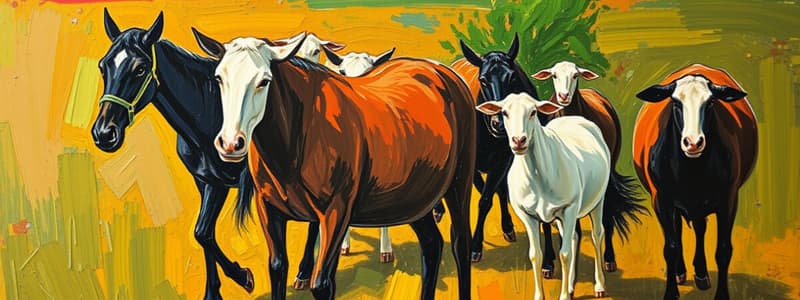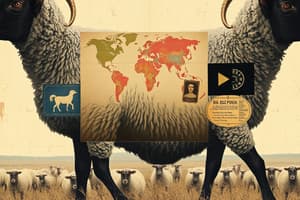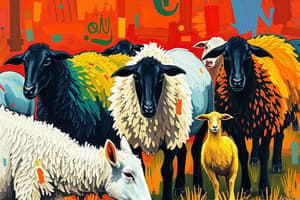Podcast
Questions and Answers
What is the primary purpose of mulesing in sheep?
What is the primary purpose of mulesing in sheep?
- To prevent flystrike (correct)
- To enhance wool growth
- To improve meat quality
- To promote better lambing
Mulesing is considered an effective practical way to eliminate the risk of flystrike in sheep.
Mulesing is considered an effective practical way to eliminate the risk of flystrike in sheep.
True (A)
What kind of sheep is particularly associated with the practice of mulesing?
What kind of sheep is particularly associated with the practice of mulesing?
Merino sheep
The practice of mulesing can lead to the removal of strips of wool-bearing skin from around the ________ of a sheep.
The practice of mulesing can lead to the removal of strips of wool-bearing skin from around the ________ of a sheep.
What is the primary purpose of mulesing in sheep?
What is the primary purpose of mulesing in sheep?
Which organization strongly opposes mulesing?
Which organization strongly opposes mulesing?
Mulesing operations typically create a large amount of blood loss from the sheep.
Mulesing operations typically create a large amount of blood loss from the sheep.
Match the organizations with their stance on mulesing:
Match the organizations with their stance on mulesing:
Mulesing has no effect on flystrike on other parts of the sheep's body.
Mulesing has no effect on flystrike on other parts of the sheep's body.
Name one animal rights organization that has protested against mulesing.
Name one animal rights organization that has protested against mulesing.
After mulesing, lambs should be released onto _____ pasture.
After mulesing, lambs should be released onto _____ pasture.
What is a suggested alternative to mulesing for preventing maggot infestation in sheep?
What is a suggested alternative to mulesing for preventing maggot infestation in sheep?
Match the following alternatives to mulesing with their characteristics:
Match the following alternatives to mulesing with their characteristics:
How long does the mulesing procedure typically take?
How long does the mulesing procedure typically take?
Crutching requires more frequent repetition compared to mulesing.
Crutching requires more frequent repetition compared to mulesing.
What is one reason why lambs that are slaughtered soon after weaning generally do not require mulesing?
What is one reason why lambs that are slaughtered soon after weaning generally do not require mulesing?
What year did New Zealand begin phasing out mulesing?
What year did New Zealand begin phasing out mulesing?
The Australian sheep blow fly is a native species to Australia.
The Australian sheep blow fly is a native species to Australia.
Who accidentally discovered mulesing and in what year did it occur?
Who accidentally discovered mulesing and in what year did it occur?
Mulesing reduces the likelihood of flystrike by about __________ times.
Mulesing reduces the likelihood of flystrike by about __________ times.
Match the mulesing procedure components with their descriptions:
Match the mulesing procedure components with their descriptions:
What is the primary purpose of mulesing?
What is the primary purpose of mulesing?
According to Australian law, pain relief measures are mandatory during the mulesing process.
According to Australian law, pain relief measures are mandatory during the mulesing process.
What is flystrike?
What is flystrike?
What was the main condition offered by Kevin Craig to the Swedish activist for a free trip to Australia?
What was the main condition offered by Kevin Craig to the Swedish activist for a free trip to Australia?
The Australian Wool Innovation pledged to phase out mulesing by the year 2010.
The Australian Wool Innovation pledged to phase out mulesing by the year 2010.
What is the ultimate aim of the Australian Wool Innovation's program regarding mulesing?
What is the ultimate aim of the Australian Wool Innovation's program regarding mulesing?
In response to consumer pressure, the new technique of mulesing adaptation is called __________.
In response to consumer pressure, the new technique of mulesing adaptation is called __________.
Match the following individuals or organizations with their respective contributions or statements:
Match the following individuals or organizations with their respective contributions or statements:
What did the Australian wool industry do on 27 July 2009 regarding their pledge to phase out mulesing?
What did the Australian wool industry do on 27 July 2009 regarding their pledge to phase out mulesing?
The steining technique involves using high temperatures to treat the skin of lambs.
The steining technique involves using high temperatures to treat the skin of lambs.
What method was ceased by Western Australia’s governmental research stations on 1 April 2008?
What method was ceased by Western Australia’s governmental research stations on 1 April 2008?
What was the conclusion of Ellen Jongman's 2020 study regarding the pain levels of steined versus mulesed lambs?
What was the conclusion of Ellen Jongman's 2020 study regarding the pain levels of steined versus mulesed lambs?
The RSPCA believes that any painful procedure for changing the breech area in sheep is an acceptable long-term solution.
The RSPCA believes that any painful procedure for changing the breech area in sheep is an acceptable long-term solution.
Who conducted research in the early 1930s that established the link between plain-bodied Merino sheep and resistance to flystrike?
Who conducted research in the early 1930s that established the link between plain-bodied Merino sheep and resistance to flystrike?
SteinfortAgVet, which was later renamed ______, aimed to commercialize freeze branding techniques.
SteinfortAgVet, which was later renamed ______, aimed to commercialize freeze branding techniques.
What non-surgical alternative for preventing flystrike is noted as the most cost-effective?
What non-surgical alternative for preventing flystrike is noted as the most cost-effective?
Match the following non-surgical alternatives for preventing flystrike with their descriptions:
Match the following non-surgical alternatives for preventing flystrike with their descriptions:
Mulesed Merino sheep consistently had a higher incidence of flystrike compared to non-mulesed sheep.
Mulesed Merino sheep consistently had a higher incidence of flystrike compared to non-mulesed sheep.
What was released on January 25, 2021, by Ellen Jongman?
What was released on January 25, 2021, by Ellen Jongman?
Study Notes
Mulesing Overview
- Mulesing is the removal of wool-bearing skin from the breech of a sheep to prevent flystrike, a parasitic infection from fly larvae.
- The wool in the breech area can trap feces and urine, attracting flies that cause flystrike.
- Scar tissue resulting from mulesing does not attract flies, thereby reducing flystrike susceptibility.
- It is a common practice in Australia, particularly with Merino sheep known for their high wool production.
Mulesing Procedure and Impact
- Considered a skilled surgical task, mulesing can only prevent flystrike in the affected area, not elsewhere on the sheep's body.
- National Farmers Federation of Australia claims that mulesing is the most practical method to prevent flystrike, saving millions of sheep from death.
- The Australian Veterinary Association acknowledges welfare implications but supports mulesing as a necessary practice in the absence of humane alternatives.
Controversy and Animal Rights Perspectives
- Animal rights organizations, including PETA, label mulesing as cruel and advocate for more humane alternatives.
- Australian wool industry previously pledged to phase out mulesing by 2010 but later abandoned this commitment, leading to criticism from animal welfare groups.
- New Zealand's wool industry began phasing out mulesing in 2007, officially banning it by October 2018.
Flystrike and Wool Production Background
- The Australian sheep blow fly, an invasive species, is attracted to Merino sheep due to their wrinkled skin that traps dirt and feces.
- The practice of mulesing originated in the early 1930s when a rancher inadvertently discovered that removing skin reduced fly attraction following healing.
Mulesing vs. Crutching
- Mulesing involves permanent skin removal for flystrike prevention, while crutching is periodic wool removal that does not provide permanent protection.
- Frequent crutching reduces flystrike incidence but is less effective than mulesing.
Pain Management and Regulation
- Mulesing requires accreditation and training for practitioners, typically done during other procedures like tail docking.
- Mulesing causes pain, with no required pre or post-operative pain relief according to Australian law, though analgesics are often applied.
- Codes of practice since 2006 prohibit mulesing in sheep older than 12 months.
Alternatives and Non-Surgical Solutions
- Freeze branding (steining) has emerged as a non-surgical alternative, aiming to prevent wool growth without the same level of pain associated with mulesing.
- Breeding programs focus on creating Merino sheep with less skin wrinkling to reduce flystrike susceptibility.
- Research is ongoing into insecticides, topical treatments, and biological controls to manage flystrike without surgical procedures.
Industry Impact and Fashion Retailer Responses
- Several international retailers, including Abercrombie & Fitch and Liz Claiborne, have boycotted Australian Merino wool due to ethical concerns surrounding mulesing.
- Public and celebrity pressure has intensified the demand for alternatives, leading to research funding for non-mulesing methods.
- Animal welfare groups advocate for a focus on breed modification and dietary interventions to minimize flystrike risk without surgical intervention.
Studying That Suits You
Use AI to generate personalized quizzes and flashcards to suit your learning preferences.
Description
This quiz explores the practice of mulesing, a controversial method used in sheep farming to prevent flystrike. Learn about its purpose, the sheep breeds commonly affected, and the implications of this practice, particularly in Australia. Test your knowledge on the ethics and effectiveness of mulesing in the agricultural industry.



